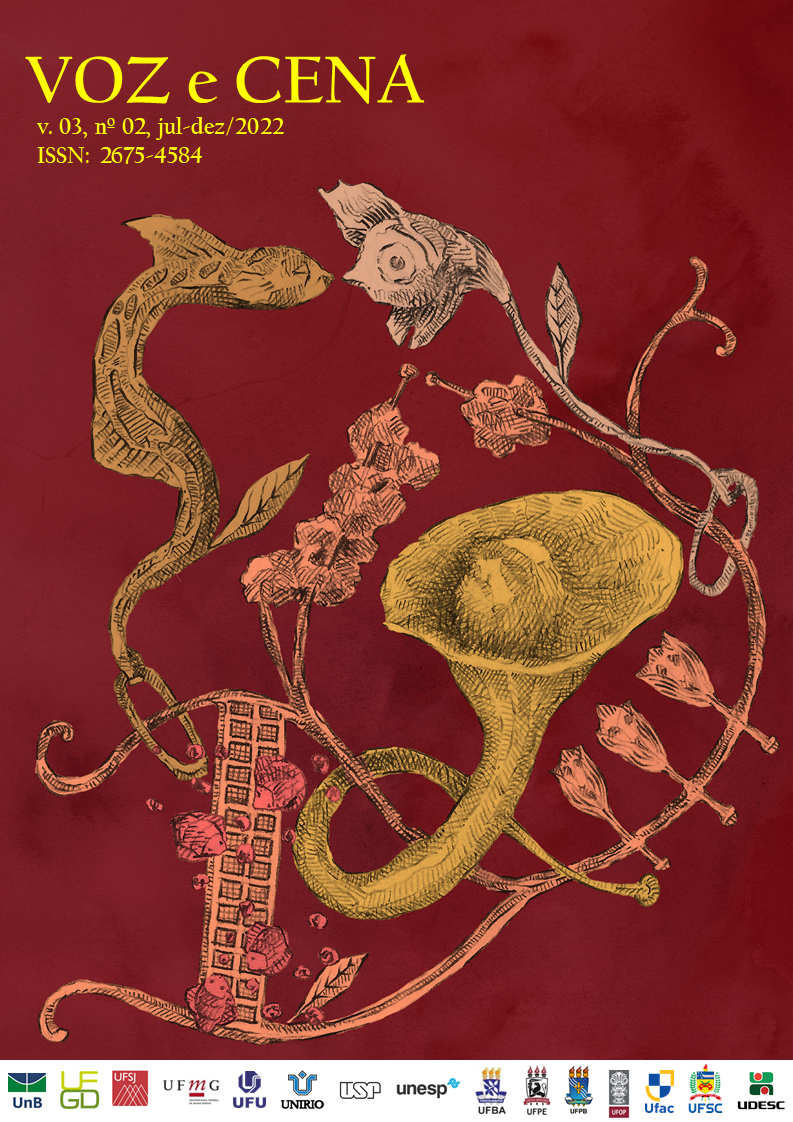The apparatus in Concert for four pianos of Lolo & Sosaku
DOI:
https://doi.org/10.26512/vozcen.v3i02.45452Keywords:
Voices, Polyphony, Devices, DiscourseAbstract
This article aims to analyze the performance Concert for four pianos by Lolo and Sosaku. For this, initially, weaknesses and vocal possibilities are evoked. Then, a brief exposition of the concepts of polyphony, discourse and device is carried out, from the perspective used in this article. Finally, the following are investigated: the release of the duo, the video direction decisions, the name of the performance, the piano and the machines that play the pianos. During this path, it is argued that the discourses created by the duo of artists are developed, above all, due to the choices and relationships with the devices used.
Downloads
References
AGAMBEN, Giorgio. O que é um dispositivo? Outra Travessia, [s. l], v. 5, n. 5, pp. 9-16, 01 jan. 2005.
BAKHTIN, Mikael. Problemas da poética de Dostoiévski 4.ed. Trad. Paulo Bezerra. Rio de Janeiro: Forense Universitária, 2008.
BRYANT, Levy. Democracy of Objects. Michigan: Open Humanities Press, 2011.
DUBATTI, Jorge. Teatro dos Mortos: introdução a uma filosofia do teatro. São Paulo: Edições SESC, 2016.
EUGENIO, Fernanda. Caixa-Livro. Rio de Janeiro: Fada Inflada, 2019.
FERRANDO, Francesca. Philosophical posthumanism. New York, NY: Bloomsbury Academic, 2019.
FERRIGNO, E. D. The Dark Side: representing science fiction in drum’n’bass. New Review Of Film And Television Studies, [S.L.], v. 9, n. 1, pp. 95-104, mar. 2011. Informa UK Limited. http://dx.doi.org/10.1080/17400309.2011.521722.
FISCHER-LICHTE, Erika. Estética de lo performativo. Madrid: Abada, 2011.
FISHER, Mark. Ghosts of My Life: Writings on Depression, Hauntology and Lost Futures. Alresford, Hants: Zero Books, 2014.
FOUCAULT, Michel. Vigiar e punir: nascimento da prisão. tradução de Raquel Ramalhete. Petrópolis, Vozes, 1987.
HARMAN, Graham. Prince of Network: Bruno Latour metaphysics. Melbourn: Re.Press, 2009.
LIGNELLI; ROBERTO, Gil. Vozes do Fracasso. In: LIGNELLI; GUBERFAIN, Jane Celeste (org.). Práticas, poéticas e devaneios vocais. Rio de Janeiro: Synergia, 2019. pp. 1-237.
MAGALHÃES, Diogo.; FILHO, José. Por que é mais difícil escutar os sons graves do que os sons médios e agudos?. Caderno Brasileiro de Ensino de Física, v. 34, n. 1, pp. 331-338, 2017.
MALETTA, Ernani. Atuação Polifônica: Princípios e Práticas. Belo Horizonte: Editora UFMG. 2016.
MARTINEZ POSADA, Jorge Eliécer. El dispositivo: una grilla de análisis en la visibilización de las subjetividades. Tabula Rasa, Bogotá , n. 19, p. 79-99, Dec. 2013 . Disponível em: http://www.scielo.org.co/scielo.php?script= sci_arttext & pid=S1794-24892013000200004 & lng= en nrm=iso. acesso em out, 2022.
SILVA, Carlos Eduardo. IL DIAVOLO. ALL’OPERA: representações do diabo na ópera oitocentista Guavira Letras , Três Lagoas/MS, v. 15, n. 29, pp. 371-385, jan./abr. 2019.
TEITELBAUM, R. Intervallic Relations in Atonal Music. Journal Of Music Theory, [S.L.], v. 9, n. 1, p. 72, 1965. Duke University Press. http://dx.doi.org/10.2307/843150 .
ZIZEK, Slavoj.; FIENNES, Sophie. The pervert’s guide of ideology, Zeitgeist Films, 2012.
Downloads
Published
How to Cite
Issue
Section
Categories
License
Copyright (c) 2022 Voz e Cena (Voice and Scene)

This work is licensed under a Creative Commons Attribution 4.0 International License.
Readers are free to download, print and use the articles published in the journal, as long as there is always explicit mention to the authors and to the Voz e Cena journal and that there is no change in the original work. Any other use of the texts must be approved by the authors and the journal. By submitting a paper to Voz e Cena journal and having it approved, the authors agree to assign, without remuneration, the rights of first publication and the permission for the journal to redistribute that article and its metadata to the indexing and reference services that its publishers deem appropriate.
This work is licensed under a Creative Commons Attribution 4.0 International License.![]()
We recommend that all authors consult the guidelines of the Committee on Publication Ethics (COPE) before submitting texts for evaluation:
- COPE Ethical Guidelines for Peer Reviewers
http://publicationethics.org/files/Ethical_guidelines_for_peer_reviewers_0.pdf
- Guidelines on Good Publication Practice
http://publicationethics.org/files/u7141/1999pdf13.pdf
- How to handle authorship disputes: a guide for new researchers
http://publicationethics.org/files/2003pdf12_0.pdf
Plagiarism detection
https://www.ithenticate.com/
https://copyspider.com.br/
http://www.plagium.com/
http://www.plagiarismcombat.com/
http://plagiarisma.net/pt/
http://www.duplichecker.com/
http://www.plagiarismchecker.com/help-teachers.php
http://www.plagscan.com/plagiarism-check/
http://plagiarismdetector.net/
For more information, check the Statute of Voz e Cena journal.


7.PNG)




